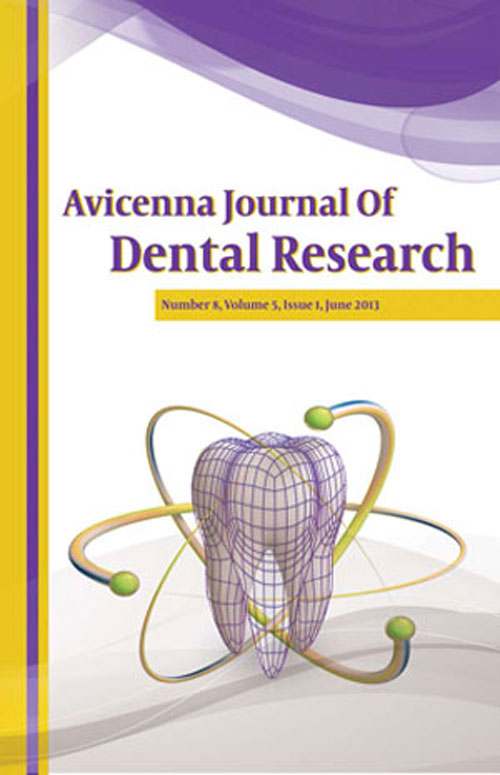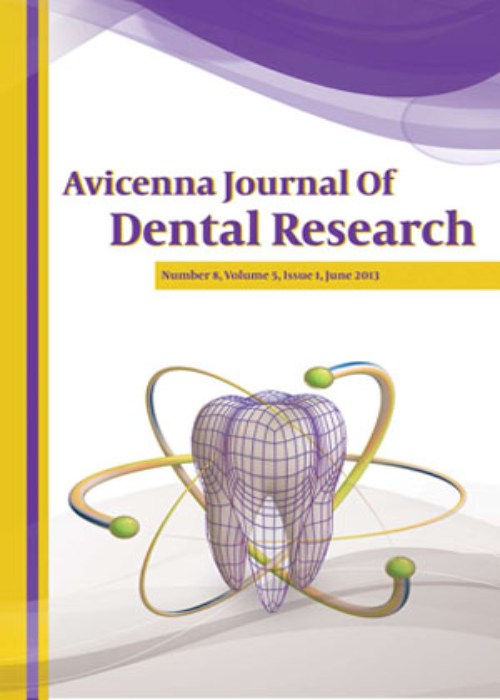فهرست مطالب

Avicenna Journal of Dental Research
Volume:10 Issue: 1, Mar 2018
- تاریخ انتشار: 1396/12/15
- تعداد عناوین: 8
-
-
Pages 1-5BackgroundBreast milk is a highly nutritious food for children which affects the craniofacial development. Breastfeeding also plays a significant role in muscle function and alignment of the teeth in dental arch. Given the resources in determining the evaluation of malocclusion and harmful oral habits, in this study we aimed to determine the effect of child feeding methods on non-nutritive sucking habits and anterior open bite.MethodsIn this cross-sectional study, 191 children aged 3 to 6 years from different kindergartens of Hamadan city were studied. Data were based on the questionnaires that were answered by parents. Then children were classified into the following 4 groups based on the history of breast-feeding: G1- bottle fed, G2- breast fed for less than 6 months, G3- breast fed for 6 to 12 months, G4- breast fed for more than 12 months. Children were examined for the presence of anterior open bite. Data were collected and analyzed by statistical tests. Pearson chi-squared test, logistic regression and Fisher exact tests were used.ResultsThe statistical analyses showed that demographic characteristics such as children’s age and birth order, maternal education, employment, and family income had no impact on child feeding methods and there was no significant relationship between them. Moreover, no meaningful relationship was found between non-nutritive sucking habits and feeding methods. Results showed that there was a significant relationship between feeding methods and incidence of anterior open bite.ConclusionsFeeding methods affect the prevalence of anterior open bite, and by increasing the duration of breast-feeding, prevalence of anterior open bite can be reduced.Keywords: Feeding methods, Non-nutritive sucking habits, Anterior open bite
-
Effect of Cigarette Smoking on Eosinophil Count in Periodontal Inflammation: A Histopathologic StudyPages 6-10BackgroundIt has been shown that cigarette smoking is associated with decreased number of eosinophil cells in blood and lung. Cigarette smoking is one of the major causes of gingival problems and periodontitis. The effect of cigarette smoking on eosinophils in gingiva has not been elucidated. The aim of this study was to determine the effect of cigarette smoking on eosinophil count in periodontal inflammation.MethodsThe study was a case-control study. Forty paraffin embedded block of periodontitis obtained from 20 cigarette smokers and 20 nonsmokers were evaluated histochemically for eosinophil count. Using hematoxylin-eosin stained sections, the number of eosinophils was determined per high power field at ×400 magnification. One-way analysis of variance (ANOVA), t test, Duncan and Pearson correlation coefficient tests were employed for data analyses at the level of P≤0.01.ResultsThe mean number of eosinophils in nonsmokers was significantly higher than that in smokers (P<0.001). The intensity of gingivitis and periodontitis in none of nonsmokers (GI: r = 0.2, P=0.37; PI: r = 0.01, P=0.95) and smokers (gingival index [GI]: r = 0.04, P=0.83; periodontal index [PI]: r = 0.23, P=0.31) were correlated to eosinophil count. The eosinophil count was higher in heavy smokers (P=0.03).ConclusionsThe eosinophil count plays no effective or critical role in smoking-induced periodontal inflammations. Increasing time of exposure to cigarette smoke affects eosinophil count in adult gingivitis/periodontitis. The dual effect of eosinophils in progressing the periodontal inflammation needs more investigation.Keywords: Cigarette smoking, Chronic periodontitis, Cell count, Eosinophil
-
Pages 11-15BackgroundSo many people worldwide have chronic periodontitis. Chemotherapeutic agents can reduce host responses to bacterial pathogens and as a result reduce bone loss.ObjectivesThe aim of this study was to compare the effect of antibiotics such as amoxicillin and metronidazole (AMX+MTZ) with ciprofloxacin (CPF) as an adjunct to scaling and root planing (SRP) in pocket depth (PD) and clinical attachment loss (CAL) in patients with moderate to severe chronic periodontitis.MethodsIn this randomized double-blinded placebo-controlled clinical trials, 45 patients with chronic moderate to severe periodontitis were randomly divided into 3 groups: the control group which received SRP plus placebo, the test 1 group which received SRP plus AMX+MTZ, and the test 2 group which received SRP plus CPF. PD and CAL were measured in each group at 3 time points (baseline, 1 month and 3 months after SRP). Statistical analysis was done using a paired t test and ANOVA.ResultsMean PD and CAL in the test groups were compared to the control group and no significant changes were found (P<0.05). Most changes in PD and CAL were seen at one month after intervention. Better outcomes were seen in the test groups (test 2 better than test 1).ConclusionsAMX+MTZ or CPF as an adjunct to SRP had better outcomes but did not have any significant impact on reducing PD and CAL over one 1 and 3 months after treatment in patients with chronic periodontitis.Keywords: Amoxicillin, Chronic periodontitis, Ciprofloxacin, Clinical attachment loss, Metronidazole, Pocket depth
-
Pages 16-21BackgroundMaxillofacial fractures are frequently complicated with injury to the eye and its adnexa. These injuries may result in loss of vision in one or both eyes or may compromise ocular function. This study aimed to evaluate ocular injuries in the patients with maxillofacial trauma.MethodsTwo hundred patients with maxillofacial fractures were examined by maxillofacial surgeons and suspected cases of ocular injuries were referred for ophthalmologic consult. Sixty-three patients were excluded from the study due to death and low Glasgow Coma Score (GCS). Patients’ information including maxillofacial fractures and ocular injuries were recorded in check lists and analyzed with SPSS software version 16.0.Resultsout of 137 patients, 106 (77.4%) were males and 31 (22.6%) were females and their mean age was 34.1 ± 17.1. The age group with the highest rate of involvement were 21-40 years (46%). The most common cause of injury was motorcycle accident (32.1%), car accident (30.7%), and in the third place was falling down (13.9%). The incidence of right eye injuries was 5/9%. Right eye was also involved more frequently than left eye (38% and 32.1%, respectively), and in 41 cases (29.9%) both eyes were involved. The prevalence of minor ocular injury was 52.6%, moderate injury was 24.8%, and major injury was 22.6%. The most common ocular injuries were periorbital ecchymosis (83.9%) and subconjunctival hemorrhage (72.2%), and unfortunately 5 cases (3.6%) lost their vision.ConclusionsThe significant prevalence of ocular injuries due to maxillofacial trauma certifies the necessity of immediate ophthalmologic examination to prevent permanent vision loss. A multidisciplinary team composed of neurosurgeons, plastic, oral and maxillofacial, ENT and ophthalmic surgeons are suggested to improve management of maxillofacial trauma.Keywords: Ocular Injuries, Maxillofacial Fractures, Blindness
-
Pages 22-27BackgroundThe present study aimed to evaluate the demographics of the patients who applied for implant treatment to Inonu University, Faculty of Dentistry, Department of Prosthodontics between 2010 and 2016.MethodsIn implant patients, implant locations, type of restoration after implant treatment, age and gender of the patients were determined using Metasoft software. FDI numbering system was used for implant locations. Descriptive statistics were analyzed using chi-square test (P<0.05).ResultsIt was found that a total of 1000 patients (410 males, 590 females) received 2955 implants during the specified period. 1052 implants were received by individuals between the ages of 41 and 50. There were statistical differences between age groups based on the implants in tooth numbers 14, 27, 34, 36, 37, 44, 46, and 47 (P<0.05) that were frequently implemented in 41-50 year old patients. It was found that the most frequent restoration type was single crowns and the first molar tooth received the highest number of implants. It was found that the regions that received the highest number of implants were the mandible and posterior regions.ConclusionsIt was determined that the number of implants in the mandible increased with the age of the patients. It was observed that the implant-supported prosthetic treatment options varied based on the state of the jaws, the localization and width of the edentation, the income levels of the patients and their gender.Keywords: Implant location, Age, Gender, Implant supported prosthesis
-
Pages 28-30IntroductionKnowledge about the anatomy and morphology of the root canal system plays an important role in the prognosis of endodontic treatment and its success. Maxillary third molars with two distobuccal canals have been rarely reported. Herein, we report a maxillary third molar with 2 canals in the distobuccal root and describe its successful endodontic treatment.Case PresentationOur patient was a 67-year-old man referred to a private endodontic clinic complaining of pain in his maxillary right third molar tooth. With the diagnosis of irreversible pulpitis, the tooth underwent root canal therapy, during which, after thorough negotiation of orifices, a second distobuccal canal was found. Cleaning and shaping were carried out and root canals were filled. A follow-up was scheduled to ensure a successful endodontic treatment.ConclusionsIn this case, we did not use any adjunct diagnostic modality. We only found an additional canal by extending the access cavity and paying attention to landmarks by probing the fissures and grooves between the main orifices. However, it seems that use of new methods can enhance a successful treatment especially in the elderly patients.Keywords: Maxilla, Molar, Root canal therapy, Third
-
Pages 31-34IntroductionAn important issue in treatment planning and endodontic treatment is to deal with sophisticated internal dental morphology. Deviations from normal anatomy in maxillary molars are usually related to the number of canals in mesiobuccal root. Although unusual anatomy is not uncommon in maxillary molars, the occurrence of 3 separate canals with distinct orifices and apical foramina (as we see in this case) is extremely rare. Getting familiar with this unusual anatomy helps clinicians to treat patients more efficiently with less chance of failure.Case PresentationThis case report describes a successful endodontic management of an uncommon variation of the maxillary first molar with a third mesiobuccal canal. The tooth had a deep carious lesion and the pulp was irreversibly damaged causing pain on the left side of the face. The periodontium was normal. The tooth received root canal treatment and 400 mg ibuprofen was prescribed every 6 hours for 2 to 3 days. The patient remained asymptomatic and the 3-month follow-up radiograph revealed normal periodontium.ConclusionsInability to identify and treat additional canals that are very common in the MB root of maxillary first molar could lead to treatment failure.Keywords: Root canal therapy, Maxillary first molar, Dental pulp cavity, Additional canals, Mesiobuccal root
-
Pages 35-38IntroductionEwing sarcoma (ES) is a rare primary malignant tumor of the maxillofacial area. On the other hand, the primary involvement of the mandibular condyle is really very rare and any misdiagnosis may significantly affect the prognosis of the disease.Case PresentationThis report describes a 29-year-old female patient who has been treated for temporomandibular disorder before being referred to our department. The patient was admitted with a diagnosis of ES and managed by primary induction chemotherapy, followed by tumor resection, radiotherapy and postoperative chemotherapy.ConclusionsES of the mandibular condyle is really rare. Therefore, early diagnosis and multimodal therapy are essential for having a better prognosis of these lesionsKeywords: Ewing’s sarcoma, Temporomandibular disorder, Condyle


